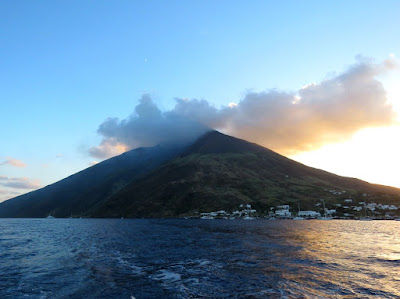PHOTOS BY GRAZIA MUSUMECI
STROMBOLI è un nome di origine greca (strongyle) che significa "rotondo", "trottola" e fa riferimento alla forma del piccolo vulcano-isola situato nel mar Tirreno, tra la Sicilia e la Calabria. Amministrativamente Stromboli fa parte della provincia siciliana di Messina, e del comune di Lipari, nelle Eolie. Geograficamente è solo la punta di un gigantesco vulcano - alto più di 3000 metri - ma sommerso per tre quarti. Trattandosi di un vulcano relativamente "giovane" ha una attività molto intensa e soprattutto continua.
Il cratere sommitale di Stromboli produce esplosioni di lava a ritmi abbastanza regolari, una ogni 15, 20 o 30 minuti circa, a seconda dei periodi. Raramente, ma anche improvvisamente, produce le cosiddette "esplosioni maggiori", ovvero la liberazione di enormi bolle di gas e lava che mettono seriamente in pericolo la popolazione dell'isola. L'ultima di considerevole entità è avvenuta nel luglio del 2019, causando anche la morte di una guida del posto. Le esplosioni di questo vulcano sono diventate l'esempio per descrivere altri fenomeni vulcanici simili, in tutto il mondo: si parla infatti di "eruzioni stromboliane".
Abitata dai tempi dei Greci e dei Romani, nel corso dei secoli l'isola ha subito anche periodi di spopolamento, a causa di siccità o di eruzioni distruttive. Tra gli anni Venti e Quaranta del XX secolo molti abitanti emigrarono in Australia e solo di recente, grazie al turismo, è tornata a popolarsi. Oggi conta circa 600 abitanti.
A Stromboli si viene per godere del mare, sulle splendide spiagge, o per tentare la salita al vulcano, accessibile fino a circa la metà della sua altezza (400 metri su 924). Le escursioni in quota avvengono quasi sempre di pomeriggio, dalle 17 fino all'ora del tramonto. Splendide anche le escursioni in barca alla Sciara del Fuoco, il grande muro di lava lungo il quale scende il fuoco delle eruzioni, direttamente in mare. Da visitare, a Stromboli: la chiesa di San Vincenzo, la chiesa di San Bartolo, la Casa di Ingrid Bergman-Museo del Cinema, la Biblioteca di Stromboli, il Villaggio Preistorico, il Mulino e la Grotta della spiaggia Piscità, la sabbia nera di Ficogrande. Non perdetevi l'emozione di una passeggiata a Ginostra, villaggio di pescatori raggiungibile soltanto via mare.
Per arrivare a Stromboli: gli aliscafi e le navi partono sia da Messina che da Milazzo e Napoli. Raggiungibile anche con collegamenti dalle altre isole Eolie. UNA CURIOSITA': Stromboli è protagonista, insieme all'Etna, di una serie di vignette che si possono visionare a questo LINK.
STROMBOLI is a name of Greek origin (strongyle) which means "round", "spinning top" and refers to the shape of the small volcano-island located in the Tyrrhenian Sea, between Sicily and Calabria. Administratively Stromboli is part of the Sicilian district of Messina, and of the municipality of Lipari - Aeolian Islands. Geographically it is only the tip of a gigantic volcano - more than 3000 meters high - but submerged for three quarters. Being a relatively "young" volcano, it has a very intense and above all continuous activity. The summit crater of Stromboli produces lava explosions at fairly regular rates, one every 15, 20 or 30 minutes, depending on the period. Rarely, but even suddenly, it produces the so-called "major explosions", that is the release of huge bubbles of gas and lava that seriously endanger the population of the island. The last major one occurred in July 2019, also resulting in the death of a young local guide. The explosions of this volcano have become the example to describe other similar volcanic phenomena, all over the world: in fact, we speak of "Strombolian eruptions".
Inhabited since the times of the Greeks and Romans, over the centuries it has also suffered periods of depopulation, due to drought or destructive eruptions. Between the1920s and 1940s many inhabitants emigrated to Australia and only recently, thanks to tourism, the island has been populated again. Today it has about 600 inhabitants. Tourists come to Stromboli to enjoy the sea, on the splendid beaches, or to try the climb to the volcano, accessible up to about half of its height (400 meters out of 924). Excursions at high altitude almost always take place in the afternoon, from 5pm until sunset. Also splendid are the boat excursions to the Sciara del Fuoco, the great wall of lavic rock along which the lava descends directly into the sea, during the eruptions. Places to visit, in Stromboli: the church of San Vincenzo, the church of San Bartolo, the House of Ingrid Bergman- Museum of Cinema, the Library of Stromboli, the Prehistoric Village, the Mill and the Grotto of the Piscità beach, the black sand of Ficogrande beach. Do not miss a walk in the romantic Ginostra village, which you can only reach by boat.
To get to Stromboli: hydrofoils and ships depart from Messina and from Milazzo and Naples. Also reachable with connections from the other Aeolian islands. A CURIOSITY: Stromboli is the main character of funny cartoons you can see - only in Italian, though - at this link.


Nessun commento:
Posta un commento